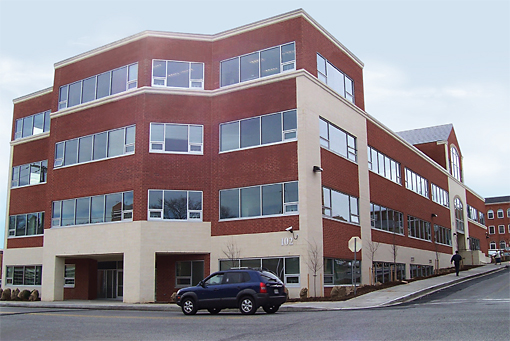| 제목 | [DAIKIN] K-12 EDUCATION - Harford Board of Education | 작성일 | 16-06-16 13:16 |
| 글쓴이 | 최고관리자 | 조회수 | 4,524 |
본문
CASE STUDY
K-12 Education
Name
Harford County Public School Administration Building
Location
Bel Air, MD USA
Facility Size
74,000 ft2 facility
Issue
A sustainable building would pay for itself
Solution
150-ton Daikin Magnitude® magnetic bearing compressor chiller
Daikin Magnitude chiller contributes to LEED® Gold for Harford County
Public Schools
In the Harford County Public School System, northeast of Baltimore, every possible penny goes into educating students. Money for capital improvements is hard to get. Although the district needed a new administration building, the school board didn't approve the project until school administration officials demonstrated that a sustainable building would pay for itself.
The school board approved the 74,000-square-foot administration building project when they learned how cost-effective it could be. Key to the efficiency of the HVAC system is a Daikin 150-ton dual Magnitude compressor chiller, which contributed to the LEED® Gold designation from the U.S. Green Building Council (USBGC). The HVAC system is expected to save 46 percent on energy compared to the requirements of ASHRAE 90.1, the nationally accepted standard on energy efficiency.
It wasn't just that the existing 119-year-old administration building had inadequate lighting, major ADA deficiencies and poor indoor air quality. It also had an inefficient HVAC system—plus the old building simply wasn't big enough. The district leased space in four additional buildings around the city of Bel Air, which made it hard to get to meetings and meant the district was paying rent without gaining equity.
"If we had gone on as we were, we would have seen our leasing costs and our energy costs go up," said Chris Morton, the district's assistant supervisor for planning and construction. "A new building solved both problems. We estimate we will break even within seven years. After that, we're ahead of the game. In 25 years, we'll be saving money because we'll own the building and have no lease payments."
Magnitude chiller: efficient, quiet and oil-free
"The Daikin chiller is by far the most efficient piece of equipment in the entire building," said Bradley Salemie, lead HVAC engineer with Spears/ Votta and Associates, Inc., in Baltimore. The key to the chiller's efficiency is the compressor's digitally controlled magnetic bearing system. The drive shaft is suspended in midair by a system of permanent magnets and electromagnets. Positioning signals received by the electromagnets hold the shaft precisely in position within a tolerance of 0.000005 inch. Shaft position is sampled and adjusted 10,000 times each second.
The Magnitude chiller's efficiency allows it to be continuously adjustable down to 10 percent of full load. "Because of the increased chiller water temperature differential," said Salemie, "we were able to design smaller pumps and distribution piping. That saves money for first cost and operational cost." The chiller's efficiency also allowed Salemie to specify lower-than standard temperature for the water produced by the chiller. "When you make the largest and most efficient system component work harder," he said, "the rest of the building's mechanical system doesn't have to work as hard."
While a typical screw-type compressor can draw as much as 500 to 600 amperes at startup, the compressor in the Magnitude chiller's permanent-magnet motors requires only 2 amps per compressor at startup. Also, when running with a partial load, the Magnitude chiller can consume less than 0.2 kW/ton of cooling capacity at certain conditions—the most efficient performance of all available chillers in their tonnage range.
The fringe benefits of Magnitude technology
Though the school system's bottom line benefits greatly from the Magnitude chiller's efficiency, most building occupants never think about the chiller—which turns out to be yet another benefit of Magnitude design. "It's the quietest chiller I've ever been around," said Morton. "The chiller is immediately adjacent to a training space, but when you stand in that room, it's impossible to detect whether the chiller is on or off." Since the compressor rotor and impeller shaft are levitated on a magnetic cushion, there is almost none of the vibration or noise produced by conventional bearing systems.
Another considerable benefit of Magnitude compressor technology is that no oil is needed to lubricate the WMC's bearings, so there are no oil pumps, filters, coolers or heaters—and no need to dispose of used oil. That significantly reduces maintenance, mess, odor and costs.
Compared to traditional chillers of the same cooling capacity, the Magnitude chiller has a smaller footprint. That's partly due to lack of an oil system. Another size factor is the chiller's impeller, which is only between three and five inches in diameter. Other chillers have two to three-foot-diameter impellers. Together, these features make the Magnitude chiller about 24 inches smaller in width than other chillers with similar cooling capacity, so a Magnitude chiller takes up less valuable building space and is easier to move into retrofit situations.

The chiller is immediately adjacent to a training space, but when you stand in that room, it's impossible to detect whether the chiller is on or off.
Green means overall building synergy
Even with its many benefits, the Magnitude chiller could not win a LEED Gold certification by itself. The key to a green building is synergy among all building components and systems. Engineers and architects must design each system as part of the whole and understand how that system affects all others. The Harford County Schools Administration Building's synergistic green features are extensive:
- ▶ An airflow sensor and a motor-operated damper are installed in a mechanical room on each floor. Only the amount of outside air needed for good indoor air quality is allowed into the building. In the summer, a special energy recovery unit uses the cooled indoor air to reduce the temperature of makeup air being pulled into the building, which in turn reduces the load on the HVAC system.
- ▶ Light sensors positioned all around the building perimeter are connected to electric light dimmers. Therefore, electric light becomes "makeup" light added to available sunlight. This reduces the amount of heat produced, which in turn helps to control the size, initial cost and operating cost of the air-conditioning system.
- ▶ A high-efficiency boiler operates with lower-than-typical water temperatures—between 100 and 140 degrees Fahrenheit. That necessitated larger-than-usual water coils in the terminal units, but it allows the system to operate at maximum efficiency (condensing mode) under all conditions.
- ▶ About 30 percent of the building's windows are operable, so occupants can choose "free" air conditioning in cool weather.
- ▶ Low-e glass and a white TPO (thermoplastic polyolefin) roof reject heat from sunlight, further reducing the load on the HVAC system.
- ▶ Waterless urinals and dual-flush toilets reduce water use.
- ▶ The building contains little wood. Exterior walls are of glass and metal-stud construction. Most interior walls are gypsum board, which is a highly recyclable material. The wood that is used, such as in doors, is from a Forest Steward Certification source.
- ▶ The building won two LEED "innovation points" for exemplary performance in construction waste management and recyclable content. Only three percent of construction waste went to landfill.
Objective requires high level of teamwork
Despite all these green features, the building does not have the distinctive design of other LEED Gold certified buildings, according to Morton. "We met the requirements without being flashy," he said. "The building is built with public money, and we wanted to show taxpayers we were good stewards of their money." Achieving that objective required a higher level of teamwork than is typical in designing and constructing office buildings. "To achieve LEED Gold, we did not produce a pages-long performance specification," said Morton. "We just defined the LEED level to be achieved and gave that to the engineers and architects. Everyone involved in this project was focused on providing a great finished project. People showed that they cared and were out to do the right thing because it meant more money for education."
For more information about the LEED certification program, see www.usgbc.org. For specific information on LEED and its impact on HVAC systems, visit the GreenWay® Resource Center at DaikinApplied.com.
| 이전글 | [DAIKIN] K-12 EDUCATION - Chapparral HS 2016-06-16 | ||
| 다음글 | [DAIKIN] K-12 EDUCATION - Northbrook Jr High 2016-06-16 | ||






